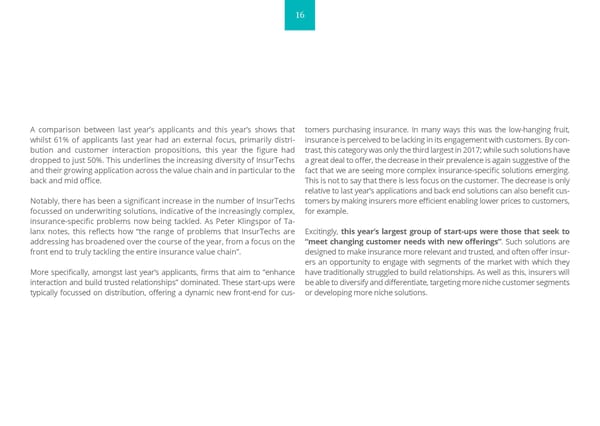16 A comparison between last year’s applicants and this year’s shows that tomers purchasing insurance. In many ways this was the low-hanging fruit, whilst 61% of applicants last year had an external focus, primarily distri- insurance is perceived to be lacking in its engagement with customers. By con- bution and customer interaction propositions, this year the figure had trast, this category was only the third largest in 2017; while such solutions have dropped to just 50%. This underlines the increasing diversity of InsurTechs a great deal to offer, the decrease in their prevalence is again suggestive of the and their growing application across the value chain and in particular to the fact that we are seeing more complex insurance-specific solutions emerging. back and mid office. This is not to say that there is less focus on the customer. The decrease is only relative to last year’s applications and back end solutions can also benefit cus- Notably, there has been a significant increase in the number of InsurTechs tomers by making insurers more efficient enabling lower prices to customers, focussed on underwriting solutions, indicative of the increasingly complex, for example. insurance-specific problems now being tackled. As Peter Klingspor of Ta- lanx notes, this reflects how “the range of problems that InsurTechs are Excitingly, this year’s largest group of start-ups were those that seek to addressing has broadened over the course of the year, from a focus on the “meet changing customer needs with new offerings”. Such solutions are front end to truly tackling the entire insurance value chain”. designed to make insurance more relevant and trusted, and often offer insur- ers an opportunity to engage with segments of the market with which they More specifically, amongst last year’s applicants, firms that aim to “enhance have traditionally struggled to build relationships. As well as this, insurers will interaction and build trusted relationships” dominated. These start-ups were be able to diversify and differentiate, targeting more niche customer segments typically focussed on distribution, offering a dynamic new front-end for cus- or developing more niche solutions.
 PwC & Startupbootcamp InsurTech: READY FOR TAKE OFF Page 15 Page 17
PwC & Startupbootcamp InsurTech: READY FOR TAKE OFF Page 15 Page 17